2016 Annual Report for GW16-044
A Collaborative Approach to Integrated Pest Management of Tadpole Shrimp in California Rice Fields.
Summary
Tadpole shrimp (Triops longicaudatus; TPS) is a vernal pool crustacean, native to the western hemisphere. It has played a role in rice ecosystems in California since the industry’s origin during the 19th century gold rush. TPS feeds on and uproots young seedlings; its swimming and burrowing habits increase the suspended silt in the flooded fields and disrupt the photosynthetic capacity of the young rice seedlings. Current control methods rely exclusively on pyrethroid insecticides for management of this significant pest, creating a high selective pressure for resistance, increasing the costs of production, and threatening the environmental neutrality of rice production. A common pyrethroid, Lambda-cyhalothrin, tripled in pounds applied between 2005 and 2013 (http://www.cdpr.ca.gov/). This high use of pyrethroid insecticides is problematic as it threatens the sustainability of rice production, an attribute that has been emphasized by the industry in terming “California Rice – The Environmental Crop” (http://calrice.org/).
Since my project began our team has expanded and I have hired five undergraduate interns interested in gaining authentic research experience in Integrated Pest Management. These students (Jenny Cesolini, Michael Nguyen, Anna Gomes, Antonia Vargas, and Kellie Moao) have become an integral part of our research team providing insights into our projects and accompanying me to Farmers Field Days in an effort to expose them to interactions with farmers and other scientists. They have experienced the challenges that accompany nearly all research projects and have worked collaboratively in creative problem solving to overcome such challenges. They have gained experience in both the field and laboratory and their schedules commonly allow them to work independently or as a team.
Objectives/Performance Targets
OBJECTIVE 1:
To determine aggregation pattern of TPS eggs in rice fields using kriging and spatial analysis by distance indices (SADIE).
IMPACT: This will allow farmers and researchers to develop an efficient sampling system to monitor and evaluate TPS populations annually and react with the appropriate management techniques, ultimately facilitating the evaluation of management practices on the TPS egg bank.
PROGRESS:
PROTOCOL: Eleven out of the eleven fields have been sampled from Colusa, Butte, and Glenn counties. Fifty 8’’ soil cores were taken in a 6m grid pattern and later subdivided by a depth of two inches. Therefore, each soil core was ultimately subdivided into 4 depths, so we can determine the effect of tilling on TPS egg aggregation (Objective 4) in addition to our first objective (Objective 1). Currently one third of these soil cores are processed. Over the next several months we plan to process the remaining soil samples and gain a better understanding of the aggregation of TPS eggs both at the soil surface and at the different tilling depths.
PRELIMINARY RESULTS: Preliminary data suggest that the eggs are aggregated and TPS are most abundant at the water outlet/check in the fields. Our initial SADIE analysis on the incomplete data yielded a P value = 0.135 which is an indication TPS eggs are aggregated throughout the field. If evenly distributed there would be 3.1 TPS eggs/ coordinate and the index of aggregation (la) = 1.1337. Aggregation maps will be generated once all soil samples across the eleven fields have been processed and data collected. These preliminary data were presented at the Annual Entomological Society of America (ESA) in Minneapolis – November 2015, International ESA meeting – September 2016, Rice Field Day August 2015 & 2016 and I am registered to present at Rice Grower meeting Jan. 26th 2017.
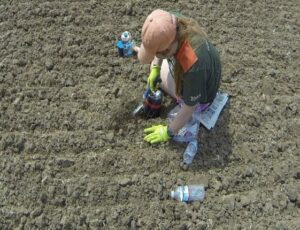
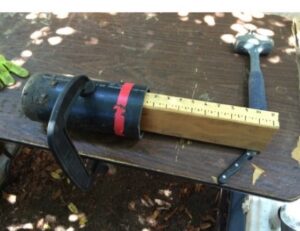
From Left to right: Me, extracting a soil core from tilled rice field. Soil core extraction and subdividing it by depth.
OBJECTIVE 2:
Characterize TPS egg “diapause profile” and hatching patterns using hyperspectral imaging techniques. Since TPS exhibit a diapause in which only a portion of the dormant eggs hatch with each flooding event, they exhibit a “diapause profile” creating an “egg bank” in the soil. Essentially, for any given egg brood only a proportion of the eggs will hatch the following year (year one), another proportion of the eggs will hatch the next year (year two) and so on and so on, in which some will remain dormant for over 20 years. Many species, especially plants, use this fitness strategy to ensure their persistence over long periods of time. With the new hyperspectral imaging technology recently acquired by UC Davis Entomology Dept., we are optimistic and excited about the possibility of finally being able to characterize TPS “diapause profiles”.
IMPACT: Characterizing TPS egg “diapause profile” and the environmental constraints on egg dormancy could prove useful in predicting future TPS outbreaks once a monitoring technique has been devised.
PROGRESS & CHALLENGES:
PROTOCOL: Challenges arose in the initial stages of the protocol when we were unable to hatch individual TPS eggs in the laboratory. Additional challenges stemmed from the inaccessibility of new hyperspectral imaging technology at UC Davis campus due to overbooking of the equipment. These two aspects are essential to the original outlined protocol. We have tentative explanations for the eggs inability to hatch individually in the lab. This phenomenon could be occurring for a multitude of reasons, some being: lack of unknown chemical communication among eggs, or lack of other unknown environmental factors eggs use as indicators for hatching. Although we have run into some initial struggles with this project we are continuing to expose the eggs to various hatching environments with hopes that one will initiate a hatching event. This would allow us to first photograph each individual egg and then record its length of diapause due to the number of flooding events needed to induce hatching.
OBJECTIVE 3:
Understand impact of changes (environmental and man-made) on TPS egg bank by characterizing factors that affect egg survival or alter diapause ratio.
IMPACT: The factors identified could be exploited to increase egg mortality and reduce egg bank.
PROGRESS:
In an effort to understand man-made changes in the rice field and their impact on live TPS survival and egg survival our team conducted two bioassays examining the effects of nitrogen fertilizers. Over the summer we conducted two bioassays, each replicated four times, testing the effects of different nitrogen fertilizers against a control and negative control on TPS survivorship and hatching rate.
Bioassay 1: Effects of N fertilizers on TPS survivorship: This bioassay consisted of 4 treatments: Control, CuSO4 (negative control), Urea & Aqua®, was conducted to compare the two most common nitrogen fertilizers (Urea and Aqua®) in California rice on TPS survivorship. Each bioassay consisted of 5 replications of each treatment, in which mason jars were filled with 3 inches of soil before being completely filled with tap water. Treatments were then applied at a field rate based on surface area and volume. Five TPS per mason jar (experimental unit) were added after treatments were applied and survivorship recorded at four time intervals. The bioassay was repeated four separate times, all exhibiting the same general trend. In addition, the Urea and Aqua® treatments received a spike of 0.28g/jar & 1.05mL/jar respectively, at the third time interval.
RESULTS: From our study we concluded that N-fertilizers have no significant effect on TPS survivorship when applied before TPS are added to the system. This is likely due to Aqua’s® ability to bind to the soil. The data also demonstrates the spike of urea had no significant effect on TPS survivorship. However, the spike of Aqua® swiftly killed all remaining live TPS. Therefore Aqua® is as good at killing TPS as copper sulfate when applied to the water instead of the injected into the soil three inches deep. Results were presented at CA Rice Field Day – August 2016 and International Congress of Entomology (ICE) meeting -September 2016.
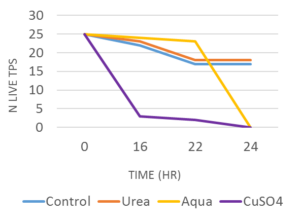
The figure to the above clearly illustrates the effect of the Aqua® spike on TPS survivorship at time interval 22.

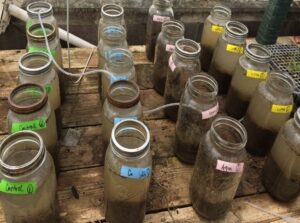
From left to right: Live TPS collected from fields. Complete bioassay deployed in a greenhouse at UC Davis campus, summer 2016.
Bioassay 2: Effects of N fertilizers on TPS hatching rate: A bioassay was conducted to examine the effects of two nitrogen fertilizers on TPS hatching rate. The two most commonly used nitrogen fertilizers in California rice production (Aqua® and Urea) were compared against a positive control and negative control (Copper Sulfate). Trays were used instead of mason jars to maximize surface area and thus hatching of TPS given that TPS eggs do not hatch if they reside below 0.5 inches of soil (Scott and Grigarick, 1979). Treatments were applied at field rate calculated from surface area and volume. Each treatment was replicated five times over two trials. Each tray received 500 g of soil dense with TPS eggs, which allowed for 0.5 soil depth across the bottom of each tray. Treatments were applied prior to flooding with 5000mL of tap water. Hatching of TPS were recorded daily via removal for two weeks per trial.
RESULTS: While urea consistently had fewer TPS hatching across both trials, zero TPS hatched in any of the Aqua® and Copper Sulfate (negative control) trays for either trial. From this data we can confidently conclude that Aqua significantly reduces TPS hatching.
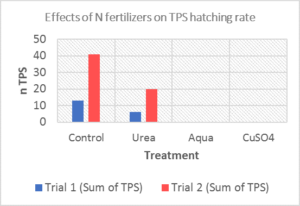
The figure above depicts the effectiveness of Aqua® and Copper Sulfate on the reduction of TPS hatching, as no TPS hatched for either treatment in Trial 1 or Trial 2.
OBJECTIVE 4:
Evaluate the effects of cultural management practices (i.e. straw burning, straw incorporation, tillage practices, and irrigation regimes). In an effort to better understand the effects of such cultural management practices four trials were designed. Some test the same phenomenon on different scales and in more controlled environments versus field environments. This will increase our knowledge about the applicability of results discovered in the laboratory.
- Mesocosm study: Comparing winter management practices (fallow, flood and burn) on TPS hatching rates.
- Burn Field Survey: A field study comparing TPS hatching rates before and after farmers’ fields are burned will give us insight into the effects of burning on the TPS egg bank and examine its effectiveness as a cultural management practice for TPS.
- Burn Field Experiment: During a field experiment we divided a field heavily infested with TPS eggs into eight sections; four sections (i.e. replicates) were burned and four were left fallow. Soil samples were collected from all sections and TPS hatching rates among the burned and fallow sections compared.
- Tilling Effects on TPS Egg Distribution: Examining the effects of tilling practices on burying and bringing TPS eggs to the surface. This is in conjuncture with the SADIE analysis (objective 1). That trial aims to examine two separate phenomenon.
PROGRESS:
Mesocosm study: The mesocosm study was conducted winter 2016 and will be repeated winter 2017 (it is currently deployed at the Rice Experiment Station in Biggs, CA). Each mesocosm (kiddie pool) was filled with rice soil densely populated with TPS eggs spanning the entire surface of the mesocosm one inch in depth. Dried rice straw was added to all experimental units at a calculated rate based off field averages and surface area. Each treatment (Flood, Fallow, & Burn) was replicated four times. From each mesocosm we collected five one liter soil subsamples before the treatments were applied (January 22nd 2016) and three months after treatments were applied (April 7th, 2016). Samples were dried completely and 500g from each sample was flooded in trays and TPS hatching rate recorded daily via removal. This experiment was repeated for winter 2017 and mesocosms were deployed Nov. 19th 2016.
RESULTS: While all treatments demonstrated a reduction in TPS from pre-treatment to post-treatment samples, these reductions were not statistically significant according to the paired t-tests (Figure 3). However, it is worth noting that the Flooding treatment exhibited the greatest reduction in TPS hatching among all three treatments and was close to significant (P= 0.0828).
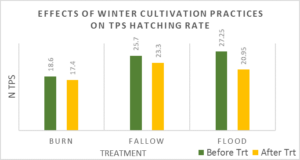
The figure above illustrates the reduction in TPS hatching from the pre-treatment to post-treatment samples across all treatments (Burn, Fallow, Flood), although none were significant to the P=0.05.
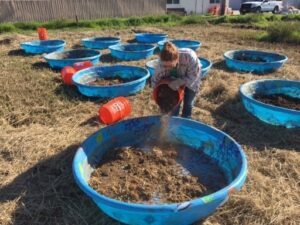
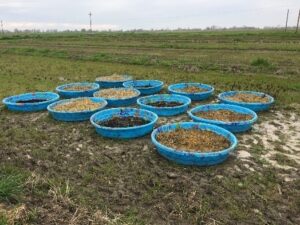
From Left to right: Me, filling the mesocosms with rice soil dense with TPS eggs. One complete mesocosm trial set up in field (4 replicates of treatments: burn, fallow & flood.
Burn Field Survey: We selected farmer’s fields dense with TPS the previous season. From these fields, we collected ten soil samples throughout the basin to get a representative idea of TPS eggs in the soil prior to burning. We took GPS coordinates at each sampling location so we can resample at the same location post burn. Three subsamples were collected from each of sample and taken back to lab to be processed. In lab, we recorded the number of TPS that hatched from each sample.
PRELIMINARY RESULTS: The sporadic early fall rains hindered our ability to sample more than three fields for the project. The air quality control designates Burn Days based on current air quality and dryness of the rice straw in the fields. Our data from the three fields demonstrate no significant difference in TPS between before and after burning (P = 0.314). We also took soil moisture readings of each field before and after burning because we hypothesize that water could insulate TPS eggs from damage due to burning. We found that burning consistently reduces field soil moisture by three percent. We are currently in the process of a lab study examining what role soil moisture levels play in insulating TPS eggs against the effects of burning.
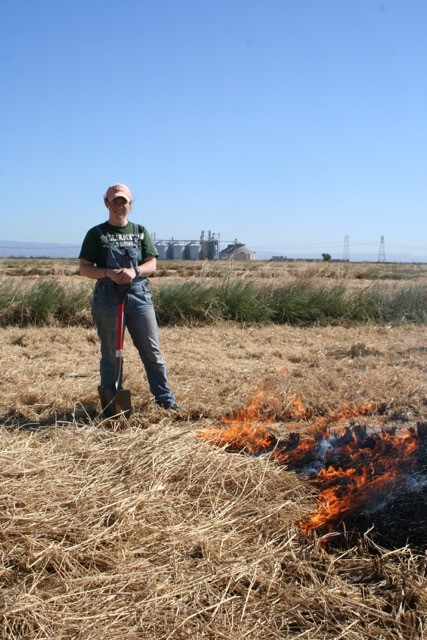
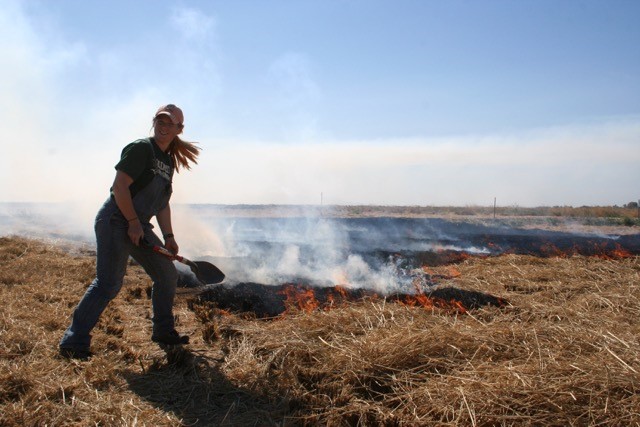
Above: Depicts me using shovel to control fire edges.
Burn Field Experiment: We selected a field at the Rice Experiment Station in Biggs, CA that was heavily populated with TPS and untreated the previous year. The field was subdivided into 8 sections (i.e. strips, see field map below) and blocked to reduce variation ultimately creating four pairs of strips. Each pair was randomly assigned a treatment of either burn or no burn. This would allow us to compare TPS populations among those strips that were burned against those that were not burned. Five soil samples were taken from each strip and hatching rate recorded.
PRELIMINARY RESULTS: We plan to repeat this study the following two years to provide a more robust understanding of the degree of the effects of burning on TPS populations. Our preliminary data in concurrence with our Burn Field Survey results demonstrates no significant difference between those strips burned and those not burned (P= 0.444). Soil moisture was not recorded due to time constraints and we predict that our current lab trial examining the effects of burning across several different soil moistures will provide more insight into our results from this study.
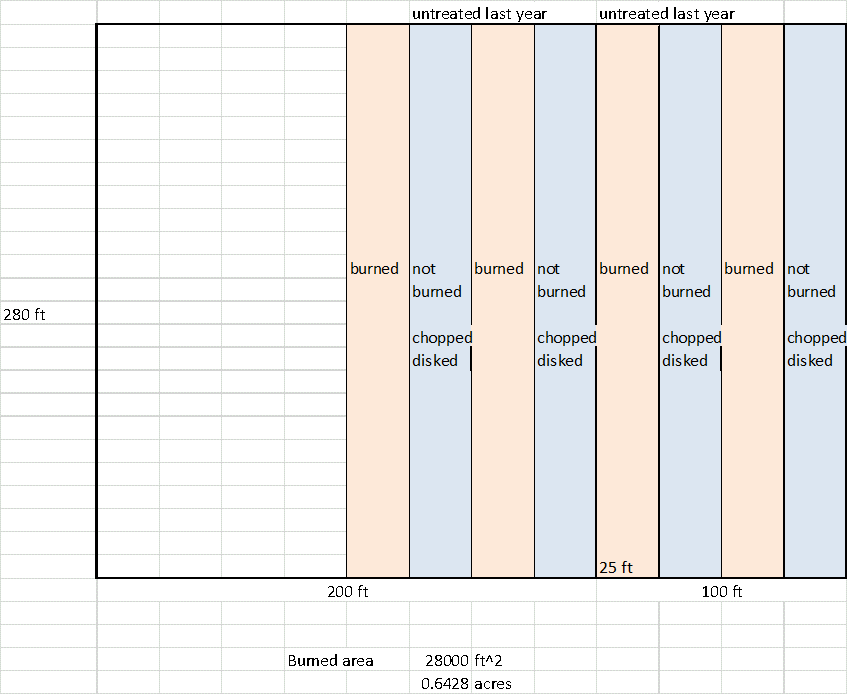
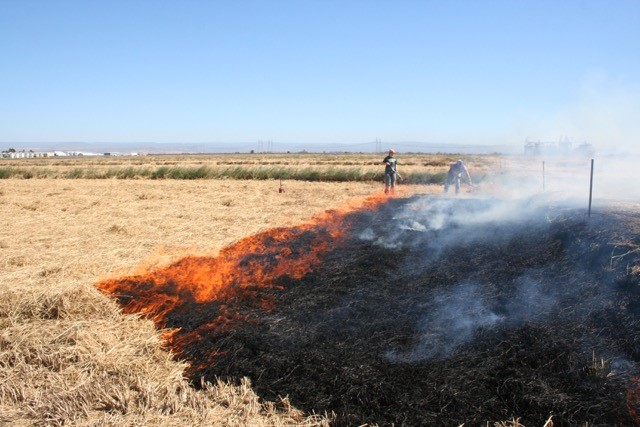
From left to right: Field map depicting how the field was divided and treatments applied before we randomized the treatments. Research team using shovels and water to control fire edges and keep fire in allotted zone.
Tilling Effects on TPS Egg Distribution: Understanding the effects of tilling on TPS egg distribution and hatching rate within the field could lead to better cultural management of TPS and a greater understanding of TPS population dynamics. A field dense with TPS was selected in Colusa Co. CA and 49 soil cores were taken in grid format before and after tilling. Each sample consisted of the top two inches of the soil profile.
PRELIMINARY RESULTS: A t-test between the before till and after till soil samples demonstrates a significant reduction (P= 0.004) in the number of TPS that hatched before versus after tilling. While this study must be repeated in more fields, preliminarily results indicate that tilling may be a significant cultural management practice in reducing TPS populations. Scott and Grigarick, 1979 showed the inability of TPS eggs to hatch below 0.5 inches of soil. Tilling presumably buries TPS eggs that lay on the soil surface after harvest. More research must be conducted to confirm this and to explore the effects of deeper tilling or more tilling passes on TPS hatching rate.
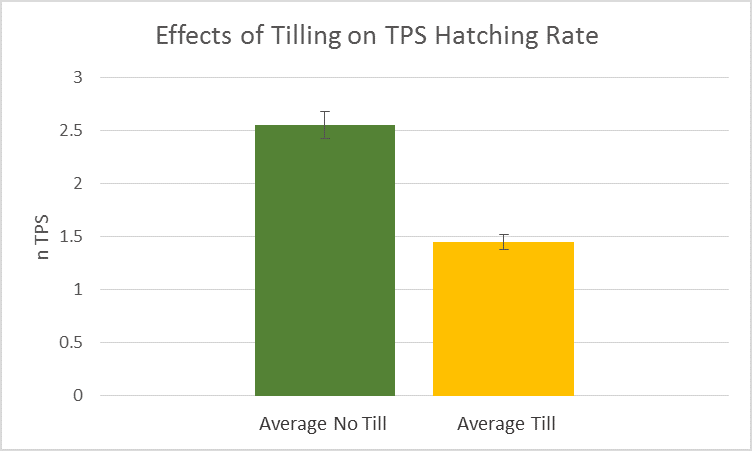
The figure above demonstrates the significant reduction in hatched TPS in tilled plots.
OBJECTIVE 5:
Explore alternative insecticide modes of actions emphasizing biorational and biological products that can effectively reduce TPS populations with minimal cost and impact on the environment.
IMPACT: Currently only pyrethroids are commonly used to manage TPS in California rice. Their mode of action is axonic excitoxins which prevent the closure of certain sodium channels within the organism. Discovering other effective chemicals with different modes of action could greatly reduce the selection pressure for resistance. For the first time, we have seen, TPS resistance to the pyrethroid Warrior® in certain farmer’s fields last growing season (April – Oct. 2016). Further increasing the need for alternative chemicals to manage TPS in rice.
PROGRESS:
PROTOCOL: We evaluated the efficacy of six different pesticides in adequately managing TPS populations and their non-target effects on other aquatic insects in the rice ecosystem. Aluminum rings were deployed in a rice field at the Rice Experiment Station to act as experimental units. Each treatment was replicated 5 times. The six chemicals selected for this trial were based off their modes of action, environmental impact and applicability to the pest. The chemicals chosen were: Coragen®, Belay®, Dimilin®, AZA Direct®, Warrior®, and Copper Sulfate. Coragen® insecticide’s active ingredient is Rynaxypyr®, which has a unique mode of action; controlling pests resistant to other insecticides. Its selectivity to non-target arthropods conserves natural parasitoids, predators and pollinators. It has remarkably low mammalian toxicity, favorable toxicological profile and very low use rates. Belay® insecticide is a neonicotinoid that is more active on plant bugs, stink bugs, beetles and weevils, including rice water weevils, than other neonicotinoids, while offering comparable control of other important insects with sucking and chewing mouthparts. Belay® is typically softer on arthropods that act as natural enemies of insects than older classes of chemicals such as pyrethroids, carbamates and organophosphates. Dimilin® insecticide is a selective insect growth regulator that inhibits chitin synthesis and gives it a unique mode of action with a suspected lower environmental impact. AZA- Direct® is a biopesticide and is a byproduct of neem and is has a very minimal environmental impact.
PRELIMINARY RESULTS: Data is currently being processed, however preliminary results suggest: Coragen®, Warrior®, Dimilin® & Copper Sulfate® had full control, with copper sulfate acting as the control and having the lowest environmental impact out of the four chemicals; Dimilin® has the second lowest environmental impact. Belay® worked about 50% of the time. AZA Direct®, the biopesticide, did not prove effective in managing the pest. We also looked at the effects of Coragen®, Belay®, Warrior® & Bt® on non-target organisms pre- and post-flood. Below is a graph summarizing our results of the preflood impact of these chemicals on aquatic insects.
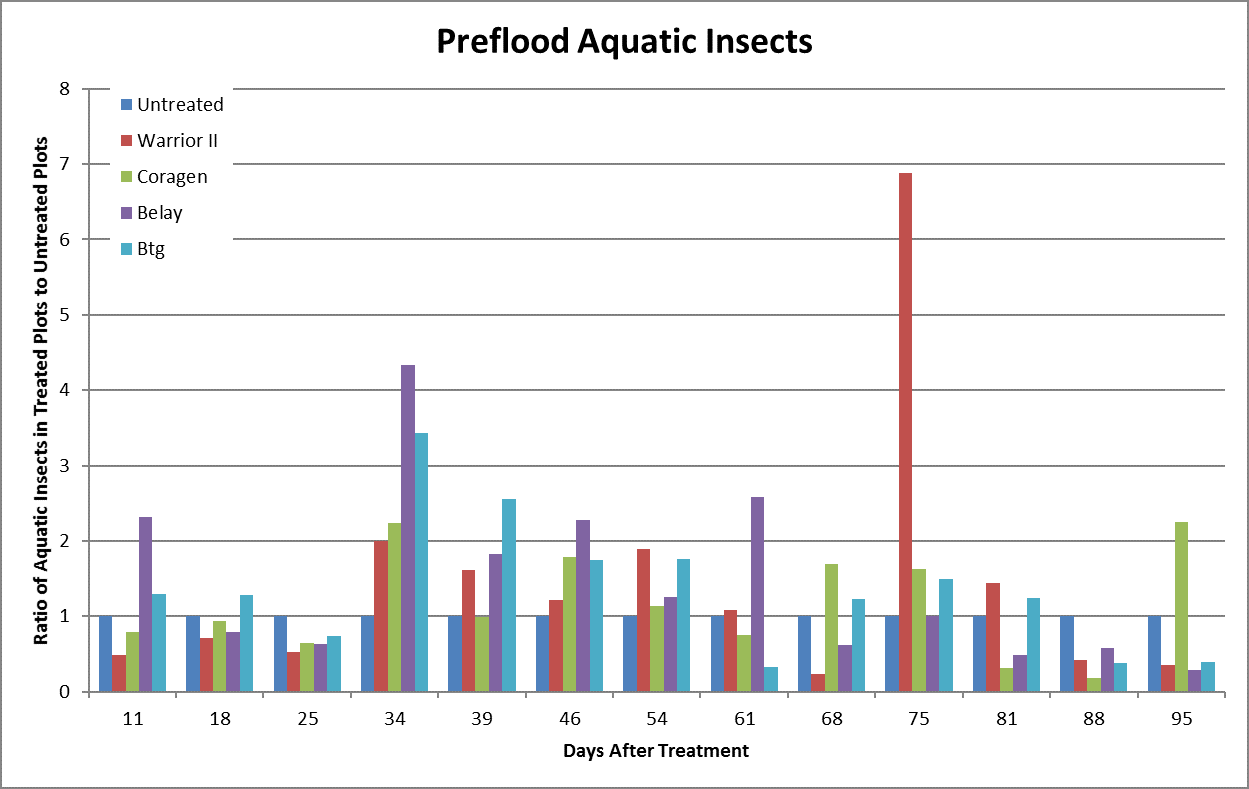
The graph above, demonstrates the Untreated at a ratio of one, and shows no clear trend for any of the non-target aquatic insects in relation to timing of sprays. It is hard to draw a strong correlation to aquatic insect colonization and timing of applications. More statistical analyses still needs to be performed to better understand these relationships.
OBJECTIVE 6:
Work together with the farmers, extension specialists and researchers cooperating in this project to disseminate findings and management strategies to other rice growers and pest control advisers through field days, grower workshops, newsletters and conferences.
IMPACT: To facilitate transparent and collaborative research in which the stake holders can actively participate in the project from its origin to its dissemination.
PROGRESS: Several farmers in Butte, Colusa, & Glenn county participated in this project through helping us find adequate fields that meet our sampling parameters. They have given us insights into their hypotheses of TPS recent transition from an occasional to chronic pest. I am scheduled to attend several grower’s workshops Jan. 26-27, 2017. Here farmers will give me input on my research, share their observations over the previous season and suggest new research avenues we should pursue in our effort to better understand and manage TPS in California rice. I have presented my projects and findings at the past two Rice Field Days (August 2015 & 2016) and plan to present again August 2017. I have been in the process of developing a blog that tracks the work of our team and creates a transparent research environment. I have presented our research at several annual Entomological Society of America (ESA) Conferences: Minneapolis, MN 2015, Orlando, FL 2016, and I am registered to present in Portland, OR and Denver, CO in 2017. Farmers and Farm Advisors have given me feedback on my projects and what studies would be most applicable for them; adding new perspectives and ideas that contribute to creative problem solving and thus innovation.
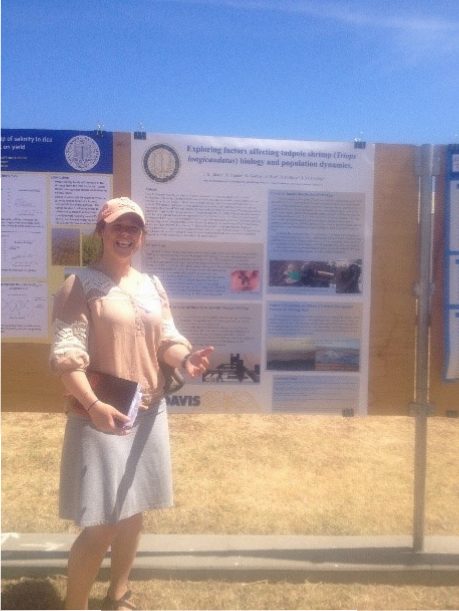

From left to right: Me standing by my poster explaining my projects and results at Rice Field Day. A screenshot of our blog, with pictures and posts containing our current projects and updates.
Accomplishments/Milestones
Our research team has developed ten separate studies under the six outlined objectives in an effort to create a comprehensive understanding of TPS in California rice systems and develop sustainable management practices. Out of these ten studies eight have been completed at least once and several repeated three to four times to gain statistical power and confirm the observed phenomena. As described in the above section, the field sampling portion of Objective 1 is completed and we are currently processing the remaining samples in the lab. We are currently trying new techniques to overcome the challenges we have faced in Objective 2. The two bioassays under Objective 3 has helped us understand the impact of nitrogen fertilizers on live TPS and TPS eggs. The four studies under Objective 4 were designed to evaluate cultural management tactics using several different methods of examination. All four studies have been completed at least once, and the mesocosm study and tilling study have been repeated three times. Based off of our preliminary results for Objective 5, we plan to repeat the study but modify it by changing some of the chemicals/pesticides tested and include more biological insecticides. Objective 6 is a continuous effort to involve all stakeholders throughout our research. I am excited to hear the farmers feedback on our progress in accomplishing this goal at the impending growers meetings Jan. 26-27th, 2017.
Please see above section for more details on the progress made with each project.
Impacts and Contributions/Outcomes
The objectives and performance targets above are a detailed outline of the progress we have made with each project. However, in this section, I would like to highlight specific examples of situations in which we particularly felt our research made an impact.
This grant has allowed me to expose undergraduates to both field and laboratory research. They have been involved in the research projects from their development (learning experimental design), to their deployment, data analysis and dissemination. They have accompanied me to Rice Field Days where they have interacted with farmers, farm advisers, other researchers and stakeholders. It has been rewarding to see the resourcefulness and creative problem solving potential of these student employees. I commonly ask for their feedback and insights on our projects and they are a valued part of our team.
This project has been one of my first opportunities to actively involve farmers in research from its origin to dissemination. This experience has only confirmed my belief that farmers are an essential part of the research process. They offer a very different perspective in contrast to researchers and offer great insights into the phenomena they observe in their fields. They are the ones actively in the field day to day, season to season. Not only have I learned from this experience, but I feel farmers have gained a better understanding of research parameters and their value. Several times, while talking to farmers, I was surprised to hear that they had small experiments of their own. After learning more about these experiments, it became apparent that my insights about experimental design could help strengthen their projects and yield more powerful and reliable results.
A large part of this projects success is likely due to the inclusive and team oriented nature of our research design. A feedback survey will also aid to the success of such team based research projects in the future. With communication, transparency and collaboration we can continue to succeed.
Collaborators:
Participant
University of California, Davis
9160 Madison Ave Apt. 130
Fair Oaks, CA 95628
Office Phone: 5174551951
PI
University of California, Davis
1 Shields Ave
367 Briggs Hall
Davis, CA 95616
Office Phone: 5307520473